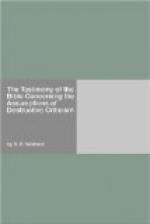Our Lord has settled the questions of the personality and work of Jonah, if anything can be settled for unbelief. He has affirmed the historical certainty of the two important events which critical assumption declares impossible. The critical Jews were demanding a sign from our Lord. He had wrought many miracles, but they wanted something beyond what he had given, a miracle for their special benefit. He declined to gratify them. Of that generation he said: “There shall no sign be given it, but the sign of the prophet Jonah. For as Jonah was three days and three nights in the whale’s belly, so shall the Son of man be three days and three nights in the heart of the earth.” (Matt. xii. 39-41.) As Jonah was miraculously preserved for three days and nights and was brought forth, as by a resurrection, so was the Son of man to be brought forth from the tomb. His resurrection was to be the crowning miracle, the sign forever confronting his nation, Jonah’s deliverance from apparent death was such a miracle as convinced the Ninevites that he had a message from God for them, so Christ’s resurrection was to become the keystone of the arch on which the whole structure of the redemptive system should rest. “He was raised for our justification.” (Rom. iv. 25.)
The reader will mark that our Lord referred to the miraculous preservation of Jonah, and his deliverance, as a historical event, recorded in the first and second chapters of the book of Jonah, not as a myth or allegory, but as a historical fact. “As Jonah was three days and three nights in the whale’s belly, so shall the Son of man be three days and three nights in the heart of the earth.” As the one, so the other. As certainly and literally the one, so certainly and literally the other. If Jonah’s preservation and coming forth from the fish that God had prepared was only a legend, then was Christ’s death, burial, and resurrection a legend. And in consistency with their critical theory some of the rationalists have reduced them both to legend. For as one was, so was the other to be. The statement is plain, definite narrative, from which there is no escape.
Others of the critical school hold to the historical verity of Christ’s burial and resurrection, but assert that he made use of the assumed legend concerning Jonah, as we might illustrate any fact in history by a familiar statement from fiction. To such an assumption we reply that our Lord was dealing with tremendous realities, such as could not be belittled by turning for support or illustration to a fictitious story. He quoted from Old Testament history to illustrate and enforce New Testament truth. On another occasion he said: “As Moses lifted up the serpent in the wilderness, even so must the Son of man be lifted up that whosoever believeth on him should not perish, but have eternal life.” Shall we hand over to legendary literature the great historical fact of the twenty-first chapter of Numbers—God’s




